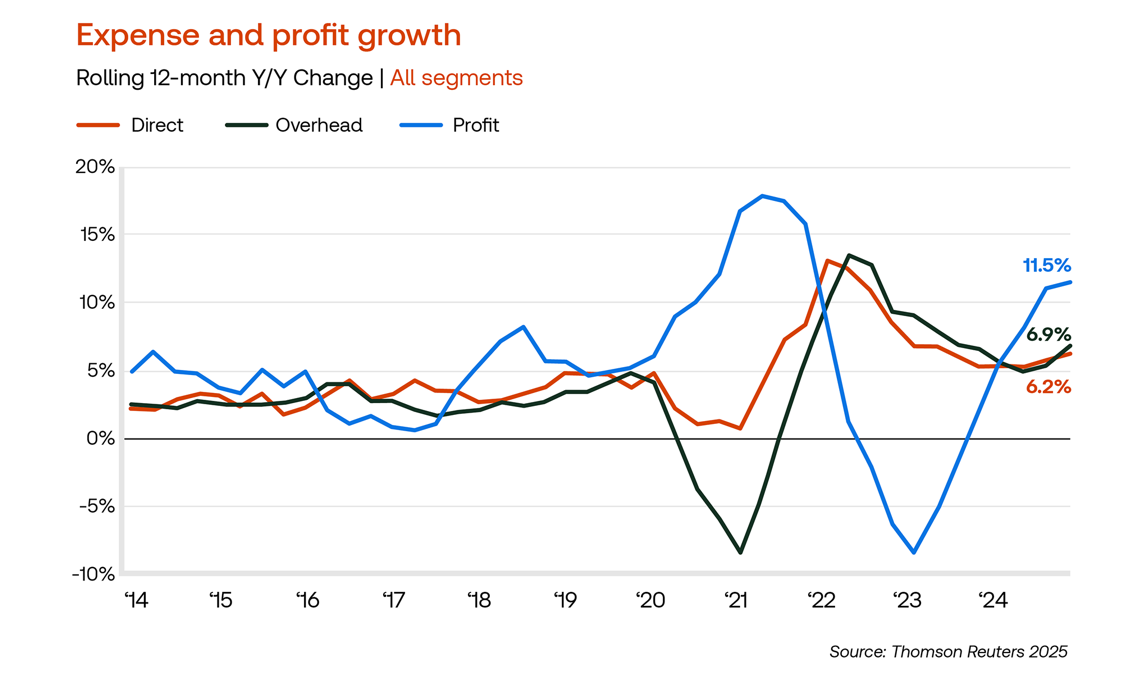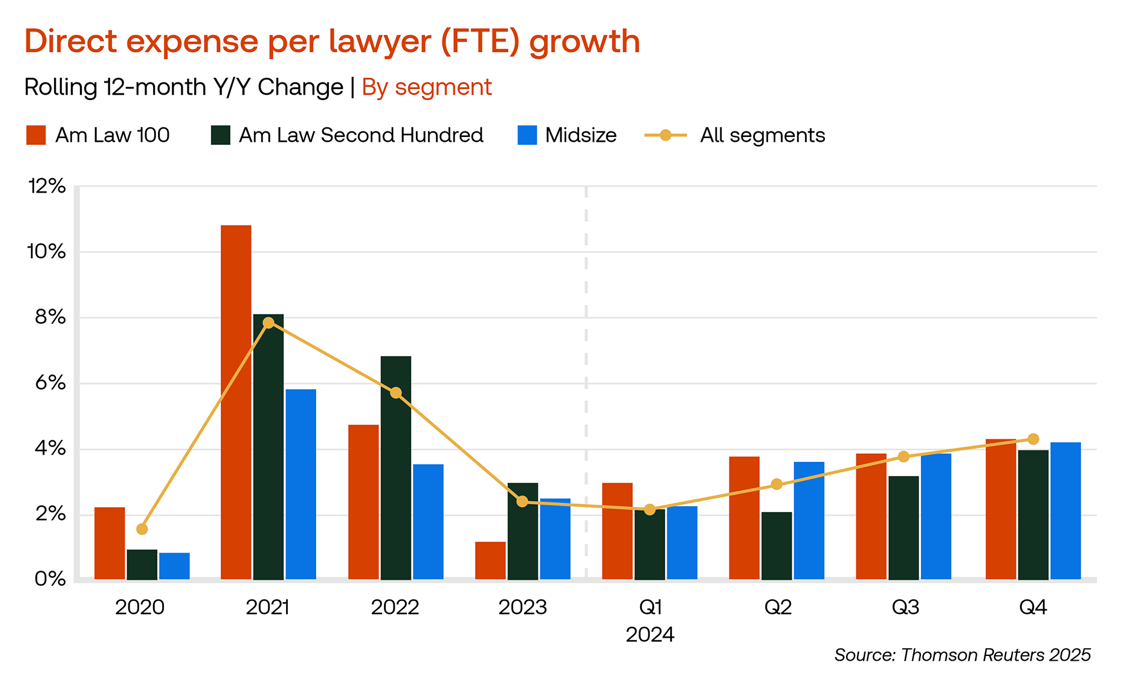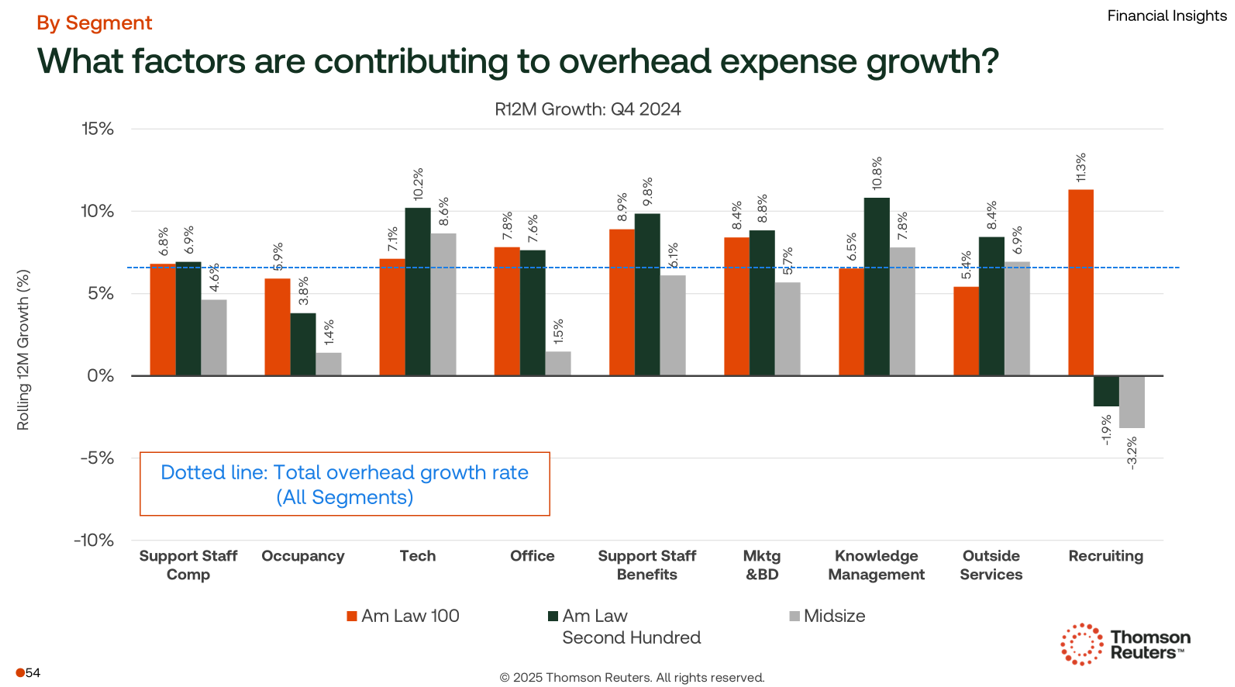This year ended with law firms recording strong profit growth which has allowed them to increase their internal investments across the board, with a special focus on talent and technology
It has been a year of record growth for law firms, with broad-based demand growth and slowing inflation leading to double-digit profit growth, a factor reflected in the most recent Thomson Reuters® Institute Law Firm Financial Index (LFFI). However, we did see a slight cooling in performance in Q4 due to increased expenses and a deceleration in some demand growth, which resulted in the LFFI score dropping to 64.
When looking at the slowing demand growth in further detail, we see that the previous record-high growth in counter-cyclical practices has slowed significantly, while transactional practices have seen a rapid increase in growth. While the latter was not enough to fully counteract the former, it is a welcome improvement to those practice areas that have been struggling since the transactional boom of 2021.
Law firms’ profit growth this year surpassed expectations, with this outcome suggesting that law firm leaders, who typically budget conservatively, saw 2024’s results as an opportunity to make sizeable investments in their firms. We saw direct and overhead expenses sharply accelerate by 6.2% and 6.9%, respectively; and by looking at these expenditures in detail we can see where leadership is focusing their key investment priorities.

The rise in overhead expenses was driven by renewed investments in technology, knowledge management, and recruiting, while the surge in direct expenses can be attributed to firms paying out sizeable bonuses. These trends give an indication that law firms believe that investing in their people and improving their technological distinction are a crucial aspect to pushing for profit growth in 2025 and beyond.
Where and why are law firms spending their profits?
When looking at data from over the last decade, we can see that 2024 experienced some of the strongest profit growth on record, with profit increases across all law firm segments reaching 11.5%. Consequently, law firms have taken the opportunity to improve compensation packages for their talent. Throughout the year, direct expenses per lawyer have gradually increased, averaging 4.3% in Q4 2024. Although this is not the highest level ever recorded, it occurs during a period of significantly lower inflation compared to the historic highs of 2021 and 2022.
Investment in talent is top priority
And unlike the intense associate compensation war of 2021, this past year has witnessed a more widespread yet milder acceleration in compensation across the market, suggesting a broader but less aggressive competition for talent — but one that is becoming increasingly competitive.

When examining the growth in overhead expenses, we observed that many law firms are investing in the development of technical systems, with above-average increases in knowledge management and business development expenses. This echoes the trend in direct expenses, suggesting that law firm leaders value the future benefits of improving core business functionality.

While occupancy growth rates remain meager across the market, Am Law firms continue to increase their office and occupancy expenses at a higher rate than other firms. This reflects a deliberate effort by leadership of these firms to continue facilitating a complete return to the office. Further, Am Law 200 firms are emphasizing improved compensation and benefits for their support staff more than are Midsize law firms, potentially highlighting a strategic focus on attracting and retaining skilled personnel in traditional business functions. Of course, the Am Law 200’s compensation growth could also be the result of increased exposure to the rapid rises in compensation pushed by the Am Law 100.
Although other overhead expenses follow broadly similar trends across the market, a key difference can be seen in recruiting expenditure growth. Am Law 100 firms have experienced an 11.3% growth in this area, contrasting with contractions seen elsewhere. Following a year of record profit growth, these large firms are willing to increase spending both internally and externally to secure and retain top talent.
As noted in the Thomson Reuters Institute’s recent 2025 Report on the State of the US Legal Market, this can be seen as an example of the cost of chasing opportunity and may signal the start of a potential talent war heading into 2025.
Investment in technology continues to grow
Technology-based solutions have long been implemented by law firms, but AI-driven tools promise transformative changes for the industry. This potential has led to a notable trend of increased tech spending, with it growing at a historically high pace of 9.4% at the end of Q4, a notable year-end acceleration from the State of the US Legal Market Report, which showed on a 7.4% growth through the end of November 2024. A rolling 12-month metric changing 2 percentage points in just one month clearly shows the size of December’s increased spend.
With clients increasingly expecting the integration of tech solutions, law firms are investing heavily in the infrastructure, getting their data in order, and AI tools themselves, despite the increasing development and maintenance costs. Many law firm leaders have said they expect these tools to provide a competitive edge in a market that is becoming increasingly competitive.
What does this mean for the future?
Law firm leaders have chosen to invest in their people and their technological offerings to prepare for the coming year. Indeed, 2024 was an exceptional year for the legal industry, but Thomson Reuters Financial Insights is predicting that the strong demand growth that we saw throughout the year (and which began to slow in Q4), will continue to erode further as we move through 2025.
At times like this, the importance of top talent will only be amplified as such talent acquisitions may be seen as the best way to bring additional work to firms. On top of that, improving firm lawyers’ efficiency will be key to justifying the ever-soaring rates to clients, as these rates return to being a more primary source for revenue generation. In fact, there are already questions being asked about increasing client pushback and the capacity of this level of sustained rate growth. So, perhaps differentiation of talent and technology can help fend off scrutiny.
The investments made in the final quarter of 2024 can define a firm and their leader’s performance in the coming years, but now that the dollars have been spent, the success of these investments will likely be determined by firms’ capacity to execute and fully utilize these investments to the fullest.







